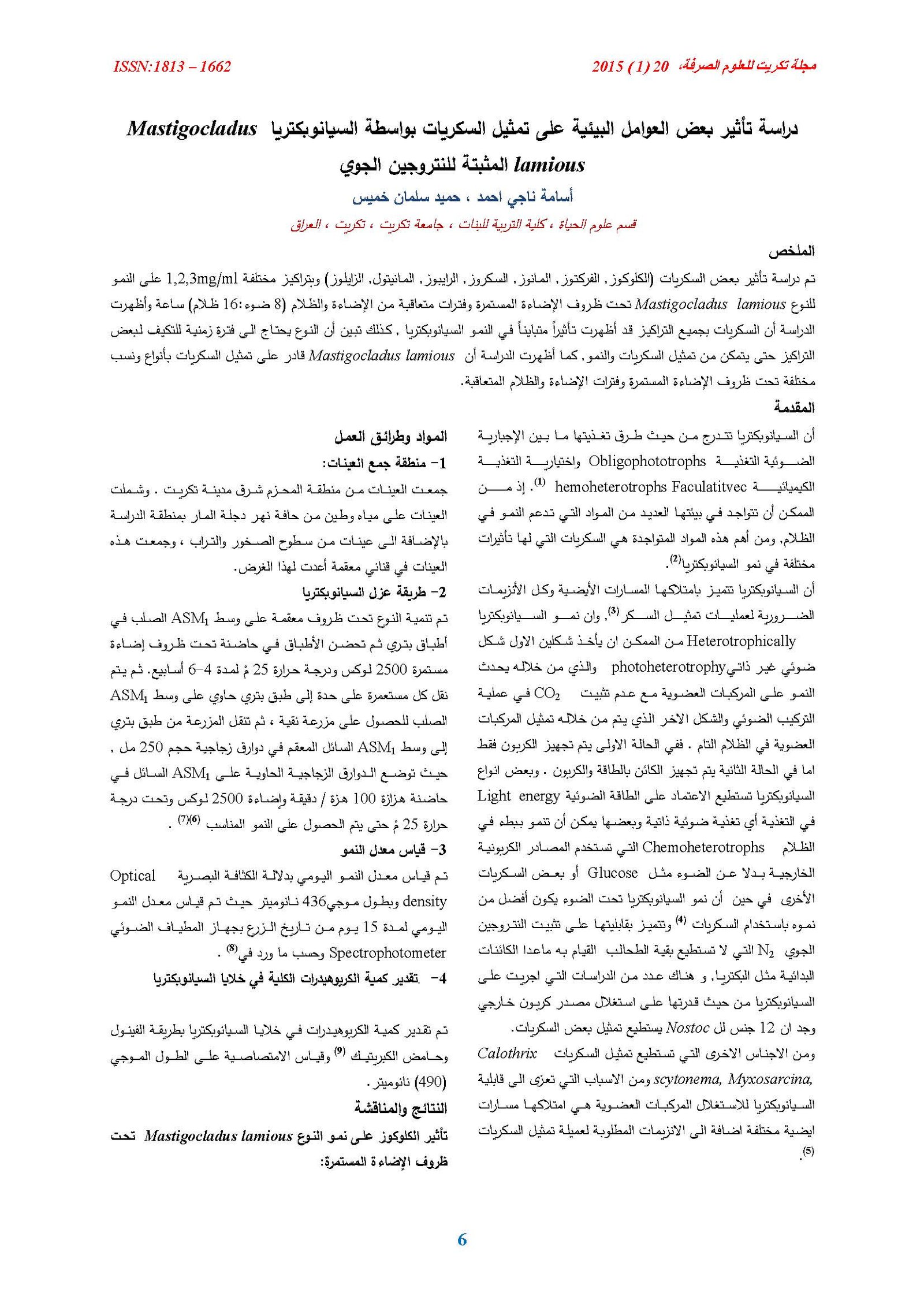Study the effect of some environmental factors on the assimilation of sugars by N2 FIXING Cyanobacterium mastigocladus lamious
Main Article Content
Abstract
The effect of some sugars(Glucose, fructose, mannose, sucrose, Ribose, mannitol, xylose) in different concentrations 1,2,3 mg/ ml on growth of species Mastigocladus lamious under continuous light and alternative light and darkness period (8 light,16 darkness)h , Result showed that sugars in all concentrations had needs a period of time to adapts for some concentrations themself before it can metabolize.
Also the study showed that the species Mastigocladus lamious able to assimilate the different sugar and different concentration under continuous light and alternative light and darkness period.
Article Details

This work is licensed under a Creative Commons Attribution 4.0 International License.
Tikrit Journal of Pure Science is licensed under the Creative Commons Attribution 4.0 International License, which allows users to copy, create extracts, abstracts, and new works from the article, alter and revise the article, and make commercial use of the article (including reuse and/or resale of the article by commercial entities), provided the user gives appropriate credit (with a link to the formal publication through the relevant DOI), provides a link to the license, indicates if changes were made, and the licensor is not represented as endorsing the use made of the work. The authors hold the copyright for their published work on the Tikrit J. Pure Sci. website, while Tikrit J. Pure Sci. is responsible for appreciate citation of their work, which is released under CC-BY-4.0, enabling the unrestricted use, distribution, and reproduction of an article in any medium, provided that the original work is properly cited.
References
1- Fay, P. (1983). The blue - green. (Cyanophyta Cyanobacteria). pp. 1-88. The Institute of Biology. Edward Arnold.
3- Zhang, X.W.; Chen, F. and Johns, M.R.(1999). Kinetic models for heterotrophic growth of chlamydomonas reinhardtii in batch and fed-batch cultures. Process Biochem., 35: 385-389.
4- Stewart, W.D.P. (1980).Some aspects of structure and function in N2- fixing cyanobacteria . Ann. Rev.Microbiol .Vol. 34:497-536.
5- Mandaville, S.M. (1997). The blue-green Algae (cyanobacteria).
العلوم، جامعة ل ، الا م .8- Foy, R.H.; Gibson, C.F. and Smith, R.V.(1976). The influence of day length, light intensity and temperature on the growth rates of plank tonic blue-green algae. Br. Phyco.J11:151-163.
9- Sadasivam, S. and Manickam, A. (2008). Biochemical method 3ed, New Age, International (P) Ltd. Publisher. pp.52.
10- Pearce, J. and Carr, N.G.(1969). The incor poration and metabolism of Glucose by Anabaena variabilis. J. Gen-Microbial. 54: 451-462.
11- Haury, H.F. and Spiller, H.(1981). Fructose uptok and influence on growth of and nitrogen fixation by Anabaena variabilis. J. bast. 1: 227 – 235.
12- Fay, P. (1965) Heterotrophy and nitrogen fixation in Chlorogloea fritschii. J. Gen. Microbiol.
39, 11-20.
13- Ernst, A.: Kllvsch hlonr D.J. and Boger, P. (1984). Glycogen content and nitrogenase activity in Anabaena variabilis . Arch . Microbal.
14- Chojnacka, K. and Marquez, F.J. (2004). Kinetic and stoichiometric Relationships of the energy and Carbon metabolism in the culture of Micro algae. Biotechnology, 3(1): 21-34.
15- Radmer, R.I. (1996). Algal diversity and commercial algal product. Biosci, 46: 263-270.
16- Zhang C-C, Jeanjean R, Joset F. (1998). Obligate phototrophy in cyanobacteria: more than a lack of sugar transport. FEMS Microbiol. Lett.161:285–292.
17- Rippka, R.; Deruelles, J.; Waterbury, J.; Hardman, M. and Stanier, R. (1979). "Generic assignments strain histories and properties of pure cultures of cyanobacteria". J. Can. Microbiol. Vol. 111: 1-61.
18- Carr, N.G. and Whitton, B.A.(1982). The Biology of cyanobacteria. Botanical Monograph, V. 19, Black Well Scientific Publication Oxford.
